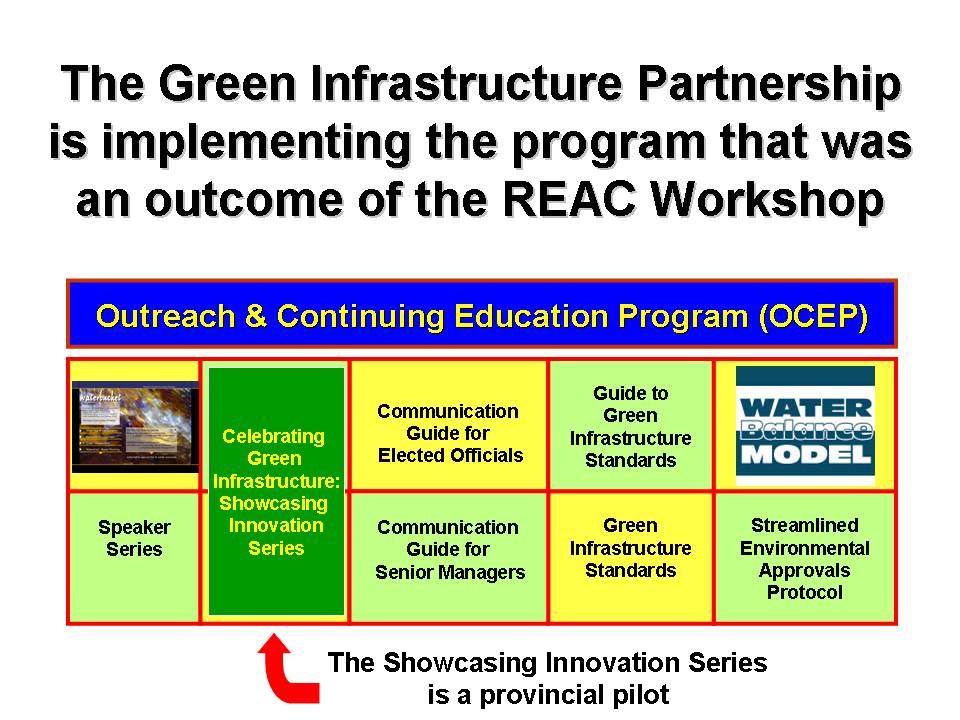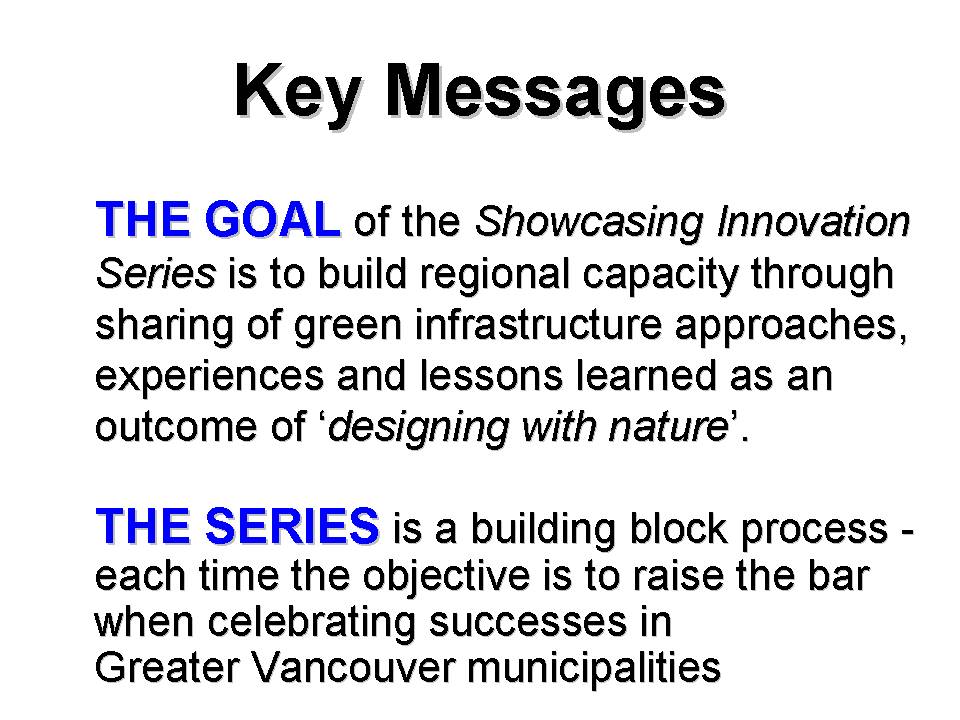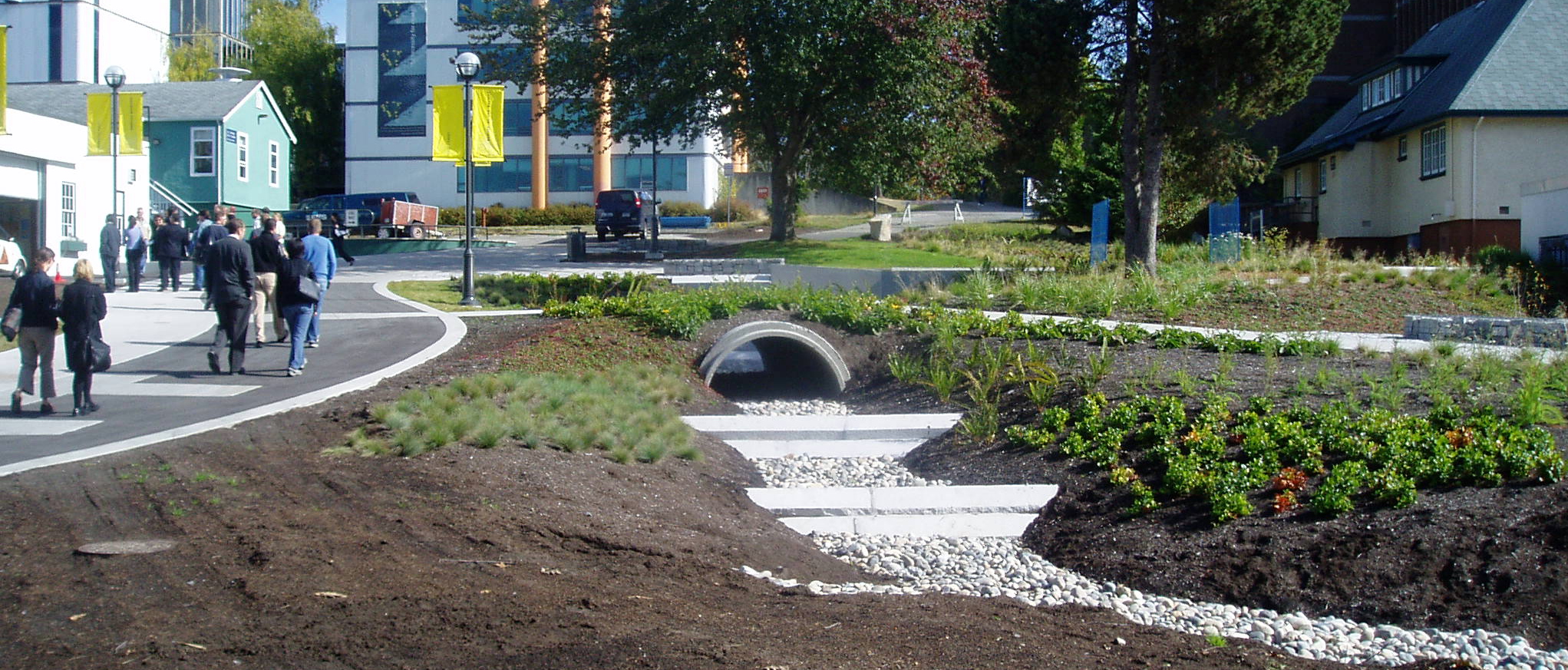Showcasing Innovation in the City of Vancouver and at the University of British Columbia
Third in 2006 series under the umbrella of the Celebrating Green Infrastructure Program
The Celebrating Green Infrastructure Program: Showcasing Innovation Series was launched in May 2006 in the Greater Vancouver Region as a provincial pilot. The program goal is to build regional capacity through the sharing of approaches and lessons learned as an outcome of ‘designing with nature’. The program is an outcome of the May 2005 Consultation Workshop organized by the Green Infrastructure Partnership in collaboration with the Regional Engineers Advisory Committee (REAC) of the Greater Vancouver Regional District (GVRD).
EVENT OVERVIEW
The third in the Showcasing Innovation Series was held on September 22 and was co-hosted by the University of British Columbia and the City of Vancouver. The unifying theme was “Greening Local Roadways – Integration of Rainwater Management & Transportation Design”. To download a copy of the Detailed Program, click on this link to Showcasing Innovation at UBC and in the City of Vancouver. Four projects were featured:
Crown Street & Country Lanes: Exceeding Expectations:
Crown Street, Vancouver’s first environmentally sustainable roadway, reflects a ‘design with nature’ approach to integrating rainwater runoff management and transportation design to achieve multiple objectives on a suburban street. To view a story on the grand opening of  Crown Street in July 2005, click on BC Municipalities Lead Way with Eco-Sensitive Streets. Vancouver’s award-winning Country Lanes are an alternative to traditional asphalt lanes and have been widely acclaimed for their innovation and community involvement. To download a copy of the Showcasing Innovation presentation by David Desrochers, click on this link to Sustainable Street Design: Exceeding Expectations
Crown Street in July 2005, click on BC Municipalities Lead Way with Eco-Sensitive Streets. Vancouver’s award-winning Country Lanes are an alternative to traditional asphalt lanes and have been widely acclaimed for their innovation and community involvement. To download a copy of the Showcasing Innovation presentation by David Desrochers, click on this link to Sustainable Street Design: Exceeding Expectations
Hydrogen Fuel Cell Car: Power to Spare!
The Vancouver Fuel Cell Vehicle Program 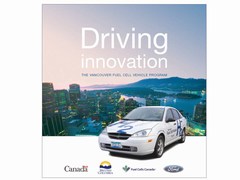 (VFCVP) demonstrates the use of hydrogen and fuel cell technologies as an alternative to gasoline. The purpose of the program is test the technology in real-world conditions and to show how greenhouse gas emissions can be reduced. This is a 3-year project. To download a copy of the Showcasing Innovation Presentation by Joy Foo, click on this link to City of Vancouver Hydrogen Fuel Cell Car
(VFCVP) demonstrates the use of hydrogen and fuel cell technologies as an alternative to gasoline. The purpose of the program is test the technology in real-world conditions and to show how greenhouse gas emissions can be reduced. This is a 3-year project. To download a copy of the Showcasing Innovation Presentation by Joy Foo, click on this link to City of Vancouver Hydrogen Fuel Cell Car
Sustainability Street Project at UBC: Beyond the Moment:
Breaking new ground at UBC, the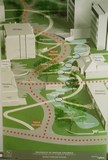 initial phase focuses on revolutionary closed-loop systems – the world’s first systems integrating rainwater runoff, wastewater treatment and ground source heating, and a small-scale biodiesel production unit which will transform waste cooking oil into a clean-burning fuel. The project is an educational resource that will evolve over time. To download a copy of the Showcasing Innovation presentation by David Grigg, click on this link to Sustainability Street at UBC: Beyond the Moment
initial phase focuses on revolutionary closed-loop systems – the world’s first systems integrating rainwater runoff, wastewater treatment and ground source heating, and a small-scale biodiesel production unit which will transform waste cooking oil into a clean-burning fuel. The project is an educational resource that will evolve over time. To download a copy of the Showcasing Innovation presentation by David Grigg, click on this link to Sustainability Street at UBC: Beyond the Moment
BUILDING CAPACITY
The Showcasing Innovation Series is organized as a 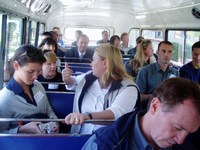 workshop in the morning followed by field tour in the afternoon. The series is structured this way to create opportunities for practitioners to network and share “how to do it” experiences on the ground. The host municipalities set the scene for the field tour by providing comprehensive and in-depth presentations. The program is designed for engineering, planning, land development, operations, and environmental departments in Greater Vancouver municipalities.
workshop in the morning followed by field tour in the afternoon. The series is structured this way to create opportunities for practitioners to network and share “how to do it” experiences on the ground. The host municipalities set the scene for the field tour by providing comprehensive and in-depth presentations. The program is designed for engineering, planning, land development, operations, and environmental departments in Greater Vancouver municipalities.
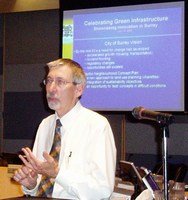 According to Paul Ham, Chair of the Green Infrastructure Partnership, “The Showcasing Innovation Series is a building block process – each time the objective is to raise the bar when celebrating successes in participating municipalities. In other words, we are encouraging friendly competition! For example, after the City of Surrey arranged with TransLink to provide experimental hybrid buses for the field tour that it hosted, the City of Vancouver one-upped this by chartering a Double-Decker tour bus.”
According to Paul Ham, Chair of the Green Infrastructure Partnership, “The Showcasing Innovation Series is a building block process – each time the objective is to raise the bar when celebrating successes in participating municipalities. In other words, we are encouraging friendly competition! For example, after the City of Surrey arranged with TransLink to provide experimental hybrid buses for the field tour that it hosted, the City of Vancouver one-upped this by chartering a Double-Decker tour bus.”
The field tour commenced with a campus ‘walkabout’ before lunch to inspect the Sustainability Street Project. After lunch, participants were taken by double-decker bus to see how the City of Vancouver projects have been implemented. To download a copy of the route map, please click on this link to Route Map for Showcasing Innovation at UBC and in the City of Vancouver
Registration totalled approximately 70, with representation from 11 municipalities.Several regional and senior government organizations were also represented. In addition, representatives of the private development and non-governmental organizations participated. Significantly, two representatives of the City of Calgary were also in attendance, thereby adding an interprovincial dimension to the day.
CONVENING FOR ACTION
The moderator for the workshop part of the day was Kim Stephens, Program Coordinator for the Water Sustainabilty Action Plan for British Columbia. In his lead-off presentation to open the workshop, Kim Stephens noted that “The Green Infrastructure Partnership is one  of six inter-connected initiatives that comprise the Water Sustainability Action Plan. The Action Plan provides a partnership umbrella for an array of on-the-ground initiatives that promote a water-centric approach to community planning.” Under this umbrella, the Green Infrastructure Partnership is promoting an integrated approach to land development – because the way we develop land determines how we use water and how water runs off the land. To view and/or download his co-presentation with Paul Ham, click on Green Infrastructure Partnership: Convening for Action in British Columbia
of six inter-connected initiatives that comprise the Water Sustainability Action Plan. The Action Plan provides a partnership umbrella for an array of on-the-ground initiatives that promote a water-centric approach to community planning.” Under this umbrella, the Green Infrastructure Partnership is promoting an integrated approach to land development – because the way we develop land determines how we use water and how water runs off the land. To view and/or download his co-presentation with Paul Ham, click on Green Infrastructure Partnership: Convening for Action in British Columbia
“When we convene for action, we build capacity through a 3-step process,” explained 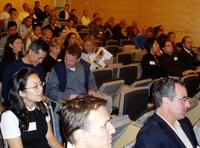 Stephens, “First, we challenge practitioners to step back from their existing way-of-thinking. Secondly, when they are ready to listen, we inform them regarding alternatives. Thirdly, we provide the tools and experience to develop land differently. This last point is the essence of what we are endeavouring to accomplish through Showcasing Innovation.”
Stephens, “First, we challenge practitioners to step back from their existing way-of-thinking. Secondly, when they are ready to listen, we inform them regarding alternatives. Thirdly, we provide the tools and experience to develop land differently. This last point is the essence of what we are endeavouring to accomplish through Showcasing Innovation.”
Sustainability Street at UBC: Beyond the Moment
David Grigg, professional engineer, is the visionary behind the Sustainability Street  project. His career spans over 39 years, with the past 15 at UBC. As the Associate Director for Campus & Community Planning, his role is to plan and regulate infrastructure improvements in UBC’s public realm. According to Grigg, “I regard my role as somewhat privileged. Ican regulate infrastructure with discretionary planning oversight and I also get to plan and direct infrastructure improvements under separate capital funding. This unique position has allowed me to pursue furtherance of UBC’s sustainability goals.”
project. His career spans over 39 years, with the past 15 at UBC. As the Associate Director for Campus & Community Planning, his role is to plan and regulate infrastructure improvements in UBC’s public realm. According to Grigg, “I regard my role as somewhat privileged. Ican regulate infrastructure with discretionary planning oversight and I also get to plan and direct infrastructure improvements under separate capital funding. This unique position has allowed me to pursue furtherance of UBC’s sustainability goals.”
David started to form his core values on sustainability as a teenager in the United Kingdom and followed closely the pronouncements of the United Nations think tank on energy – the so-called “Club of Rome”. They were indeed thinking ‘beyond the moment’ – the theme for his presentation.
A NEW KIND OF STREETSMART
“UBC is arguably Canada’s leader in campus sustainability research and practice”, added Grigg, “At Sustainability Street, we are celebrating our world-first achievements and showcasing innovative UBC technology that addresses the sustainability challenges specific to the urban environment.” To download a flyer, click on A New Kind of Streetsmart: Sustainability Street at UBC
The Sustainability Street Project on Stores Road is an opportunity for UBC to showcase the ideas and technologies developed and studied within the university, creating a gallery of invention and innovation that accentuates the interdependencies between people, infrastructure and the environment. For directions to the site, please click on this link to Campus Location Map for “Sustainability Street” on Stores Road
“Stores Road will become a visually striking, pedestrian-oriented promenade that will enhance the imageability, connectivity and social context of the campus. By turning  gathering places and learning opportunities into outdoor spaces that incorporate innovative design practices, the Sustainability Street Project will emphasize the relationship between natural processes and urban environments”, observed David Grigg when he conducted the Showcasing Innovation tour. Stores Road has been converted from a conventional paved and linear roadway to an attractive curvilinear streetscape complete with watercourse
gathering places and learning opportunities into outdoor spaces that incorporate innovative design practices, the Sustainability Street Project will emphasize the relationship between natural processes and urban environments”, observed David Grigg when he conducted the Showcasing Innovation tour. Stores Road has been converted from a conventional paved and linear roadway to an attractive curvilinear streetscape complete with watercourse
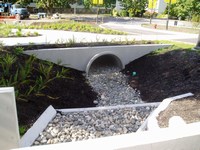 Once completed, Sustainability Street will be an interactive and educational model of public realm design that can inform and inspire projects elsewhere on campus, leaving an enduring resource for the university, the city, and beyond. To download a brochure that elaborates on the project elements, please click on this link to Sustainability Street Project Implementation
Once completed, Sustainability Street will be an interactive and educational model of public realm design that can inform and inspire projects elsewhere on campus, leaving an enduring resource for the university, the city, and beyond. To download a brochure that elaborates on the project elements, please click on this link to Sustainability Street Project Implementation
CLOSED LOOP SYSTEMS
The concept for integrating rainwater runoff, wastewater treatment and ground source heating, and a small-scale biodiesel production unit is illustrated by the sketch below. For more information, please click on this link to David’s presentation Sustainability Street at UBC: Beyond the Moment
Sustainability Street will collect wastewaster from adjacent buildings and treat it with the Smart Microbial Process to a quality suitable for re-use. In addition, ground source heat pumps will use geo-exchange heating and cooling technology to condition a portion of the adjacent Earth and Ocean Sciences building – replacing one of the building’s three natural gasfuelled hot water boilers. The water will then be discharged to the constructed rain garden and allowed to infiltrate back into the ground, closing the loop. Finally, biodiesel from waste cooking oil will be used to economically and efficiently fuel campus maintenance vehicles.
Crown Street and Country Lanes: Exceeding Expectations!
David Desrochers is the visionary engineer who has provided the driving force for the City of Vancouver’s initiatives in implementing both Country Lanes and Crown Street. “Yes, I am one who pushes the envelope in advocating new ways of  building streets and lanes”, admits Desrochers, “But I could not have made either Crown Street or Country Lanes happen without the strong support and commitment of Don Brynildsen, Assistant City Engineer (phot inset).” Below, David explains the approach to Country Lane construction at 5th and Maple:
building streets and lanes”, admits Desrochers, “But I could not have made either Crown Street or Country Lanes happen without the strong support and commitment of Don Brynildsen, Assistant City Engineer (phot inset).” Below, David explains the approach to Country Lane construction at 5th and Maple:
COUNTRY LANES
The Country Lanes Demonstration Project originated from community desire for the City to provide a more environmentally friendly and visually attractive alternative to Vancouver’s existing asphalt lanes. The initiative was further propelled by a policy directive from the City’s Corporate Management Team which encouraged staff to “incorporate enhanced sustainability into all the City Operations as a way of doing business.”
In response to this policy directive and increased community interest in an alternative lane treatment, Vancouver’s Streets Design Branch initiated a process to design a more environmentally sustainable lane. To help guide the Country Lanes Demonstration Project’s design process, the project team established the following goals and objectives:
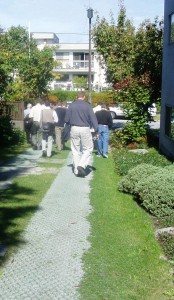 To design an environmentally positive lane treatment that incorporated natural rainwater drainage and filtration
To design an environmentally positive lane treatment that incorporated natural rainwater drainage and filtration- To reduce discharge into the sewer system, replenish groundwater andreduce peak flows into local streams and rivers
- To improve the local air quality by increasing the local green space
- To provide a more aesthetically pleasing lane treatment that would encourage residents to take more ownership of the lane and help create a more livable community
- To educate the public about rainwater management and the effects their actions might have on the local ecosystem
With an older grid street system, the majority of Vancouver’s residential neighbourhoods include rear lanes and alleys that form an important component of the city’s local transportation network. Looking back, the original lanes were simple and unpaved. Over the years however, most of the lanes have been upgraded and paved with asphalt from edge to edge through the Local Improvements process. Unlike the lanes they replaced, the new lanes are non-permeable, reduce urban green space, 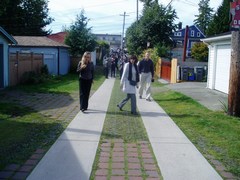 permit higher speed travel and tend not to be as aesthetically pleasing as the original lanes.
permit higher speed travel and tend not to be as aesthetically pleasing as the original lanes.
During the summer of 2003, the City of Vancouver constructed three “Country Lanes” as part of a demonstration project to evaluate more sustainable alternatives to regular lane paving.
The Country Lane Demonstration Project has also been recognized throughout the Lower Mainland, Canada and internationally with requests for design data from many cities and municipalities. The project won the 2003 Technical Innovation Award from the American Public Works Association, as well as an honourable mention for the 2003 Environmental Award from the Canadian Association of Municipal Administrators. To download a brochure prepared by Transport Canada for the Urban Transportation Showcase Program, please click on this link to Country Lanes: Greening Local Transportation
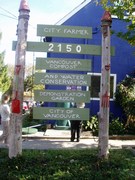 The project has also been an overwhelming success in terms of community involvement and education. The Country Lane at Maple and 5th Street is situated next to the City Farmer site. This has further raised its profile, in part because City Farrner is recognized as one of the leaders in providing service and information out ot the world about urban agriculture, wast reduction and sustainability. The photo shows the entrance to City Farmer. Of particular interest to the Showcasing Innovation participants was the green roof.
The project has also been an overwhelming success in terms of community involvement and education. The Country Lane at Maple and 5th Street is situated next to the City Farmer site. This has further raised its profile, in part because City Farrner is recognized as one of the leaders in providing service and information out ot the world about urban agriculture, wast reduction and sustainability. The photo shows the entrance to City Farmer. Of particular interest to the Showcasing Innovation participants was the green roof.
CROWN STREET
Building on the success of the award-winning Country Lanes project, the City of Vancouver has undertaken an exciting new approach to residential street design and rainwater management. Vancouver’s Crown Streethas become the city’s first Sustainable Streetscape.
The design uses innovative ideas to integrate transportation into an environmentally sensitive setting. The Sustainable Street demonstration project has provided a design that  can be used as an inspiration or template for future street improvement projects. The University of British Columbia has referenced “green street designs such as the City of Vancouver’s Crown Street” as an inspiration to “push the limits of innovation and provide a showcase of sustainability.”
can be used as an inspiration or template for future street improvement projects. The University of British Columbia has referenced “green street designs such as the City of Vancouver’s Crown Street” as an inspiration to “push the limits of innovation and provide a showcase of sustainability.”
Located in the Southlands Community of Vancouver, the 5900-6200 blocks of Crown Street  had a badly deteriorated road surface compounded by soft shoulder conditions. The street also serves as a tributary into the Musqueam Watershed, where there have been significant efforts by the Musqueam First Nation and the David Suzuki Foundation to preserve and restore two of the last remaining salmon bearing streams within Vancouver.
had a badly deteriorated road surface compounded by soft shoulder conditions. The street also serves as a tributary into the Musqueam Watershed, where there have been significant efforts by the Musqueam First Nation and the David Suzuki Foundation to preserve and restore two of the last remaining salmon bearing streams within Vancouver.
According to Don Brynildsen, “City of Vancouver’s Engineering Services responded to these challenges with an innovative design that would fit the overall character of the community, beautify the street, and nuture the salmon habitat of the adjacent streams.”
“The Crown Street design features a narrow, meandering roadway flanked by vegetated swales and retention ponds”, added David Desrochers, “The road width was reduced from the standard 8.5m to 6.7m – a center asphalt strip of 3.5m is bordered by 1m concrete strips and 0.6m of structurally reinforced grass on each side. Traffic is calmed as long sightlines are broken by the meandering alignment.”
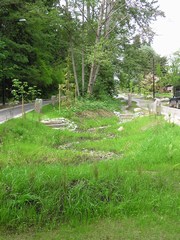 Rainwater runoff is facilitated by the network of swales and retention ponds. The broad, shallow swales are layered with 300mm of absorbent soil and vegetated with native plants. Pollutants are filtered by the vegetation and rainwater runoff infiltrates into the ground naturally. The system is designed for a 10-year storm, with overflow directed into the adjacent park. As a result, the salmon-bearing streams are protected from rain-induced volume surges and the rainwater is filtered naturally versus the roadway runoff being directly discharged into the streams.
Rainwater runoff is facilitated by the network of swales and retention ponds. The broad, shallow swales are layered with 300mm of absorbent soil and vegetated with native plants. Pollutants are filtered by the vegetation and rainwater runoff infiltrates into the ground naturally. The system is designed for a 10-year storm, with overflow directed into the adjacent park. As a result, the salmon-bearing streams are protected from rain-induced volume surges and the rainwater is filtered naturally versus the roadway runoff being directly discharged into the streams.
Water quality in the retention ponds and creek discharge is being monitored in partnership with the University of British Columbia. Over the next five years, data will be collected and compared to a neighbourhood street which utilizes standard curb-and-gutter drainage.
For detailed information on the project, click on this link to Crown Street Sustainable Streetscapes and Fish Habitat Enhancement Project to download a copy of the Completion Report which elaborates on the design, construction and monitoring elements of the project.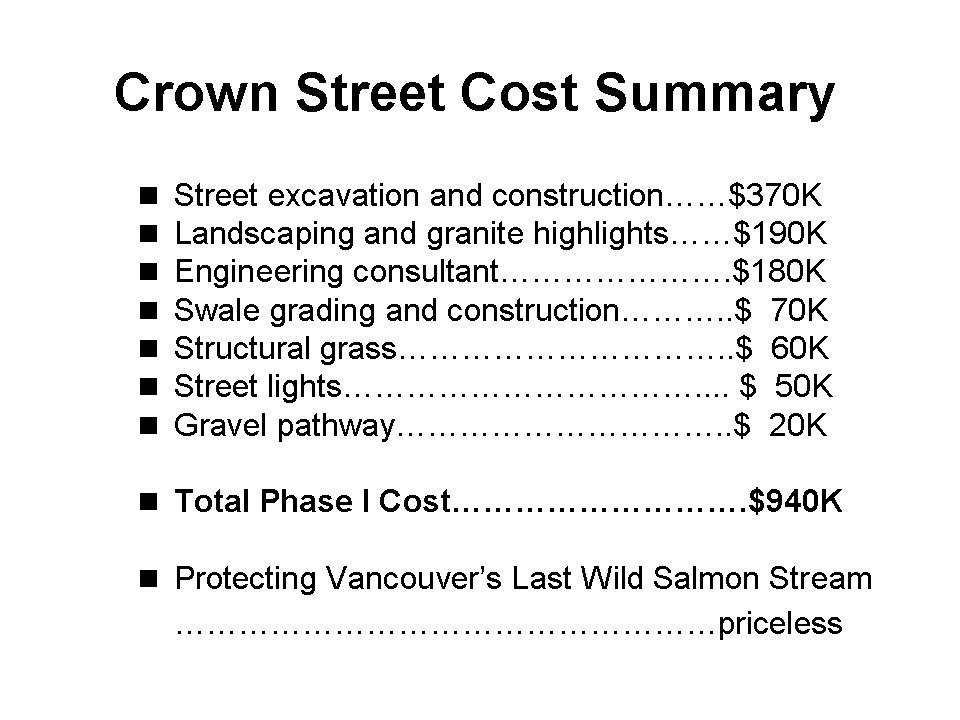
CITY OF VANCOUVER VIDEOS
To view two videos that the City of Vancouver made on its greening of roadways, click on this link to construction of Crown Street eco-sensitive roadway, and this link to construction of Country Lanes.
Event Planning
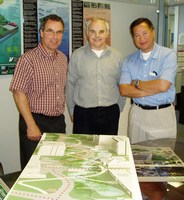 Led by Kim Stephens representing the Green Infrastructure Partnership, event planning was a collaborative effort of a joint team comprising representatives of the City of Vancouver and trhe University of British Columbia. From left to right opposite are Dave Desrochers and Steve McTaggart of the City’s Engineering Department, and Ed Lee of UBC’s Health, Safety & Environment group.
Led by Kim Stephens representing the Green Infrastructure Partnership, event planning was a collaborative effort of a joint team comprising representatives of the City of Vancouver and trhe University of British Columbia. From left to right opposite are Dave Desrochers and Steve McTaggart of the City’s Engineering Department, and Ed Lee of UBC’s Health, Safety & Environment group.
Posted November 2006



